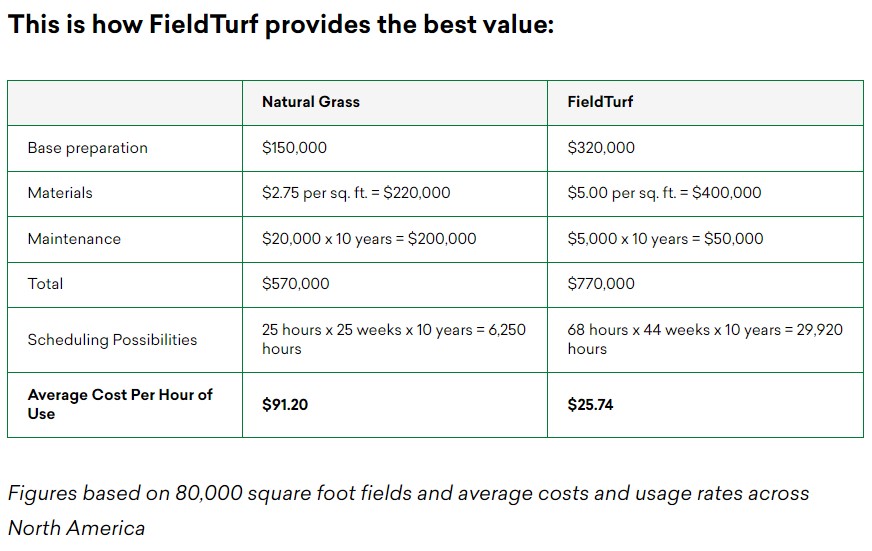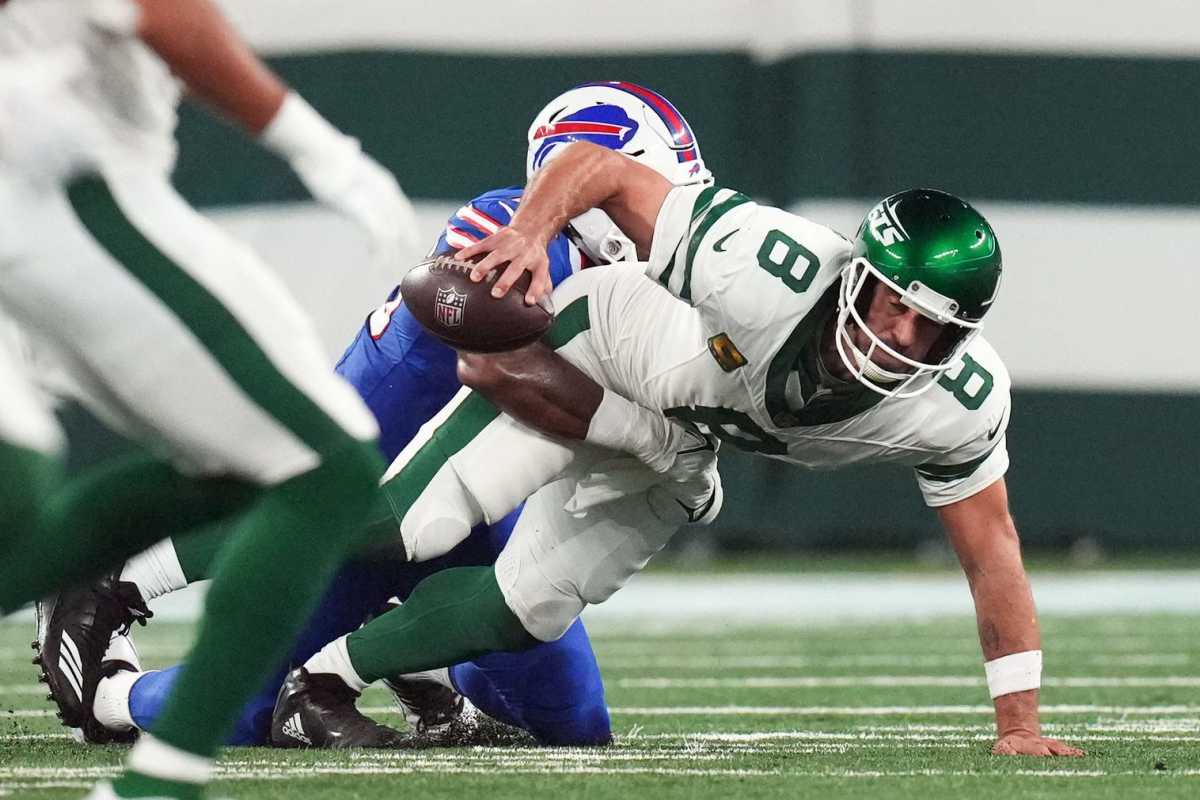Four plays into his highly anticipation NFL season, New York Jets’ quarterback Aaron Rodgers’ leg wilted after he attempted to evade an opposing defensive lineman. The sack was recorded, Rodgers stood up as normal, before dropping to the synthetic turf in disgust. The Jets’ $75M savior’s season was over – and, debatably, any gainful career the future Hall of Famer has left.
No big deal, right?
I hadn’t given the play much thought until I read a letter issued by the NFL’s Player’s Union referencing MetLife Stadium’s artificial turf as a contributor to the catastrophic injury, calling for a return to grass-only fields of play.
Specifically, players have a 28% higher rate of non-contact lower extremity injuries when playing on artificial turf. Of those non-contact injuries, players have a 32% higher rate of non-contact knee injuries on turf and a staggering 69% higher rate of non-contact foot/ankle injuries on turf compared to grass…
Until a product is developed that satisfies engineering specifications, we must take steps to protect players from unsafe field surfaces. In short, NFL clubs should proactively change all field surfaces to natural grass.
-JC Tretter, NFLPA President and Former NFL Player
Again, I didn’t think too much about it.
Until about 9 am last Saturday.
My 16 year-old’s soccer team was taking the field on a sunny, hot (about 90 degree) day in Florida. It was hot – like, REALLY HOT. And, after a tidy win, my dripping wet son accepted my awaiting “attaboy”, before commenting, “Man, I seriously thought I was going to pass out in the second half.”
Whoa – big deal.
Whoa – I suddenly thought of the safety of facility’s only synthetic turf field on which his match had taken place.
I wasn’t concerned about the big QB doing succumbing to injury on the turf, but I was damn sure concerned about my kids’ exhaustion.
Is turf safe for kids’ overall health (from injury and other)?
I see so many more turf fields at my kids’ games now, should I be concerned?
Should communities/schools invest in these fields given the potential risks?
These questions sent me down a rabbit hole – exploring topics from the chemicals used in the turf’s manufacturing process, to relative injury rates, to the costs comparison of maintaining turf versus natural grass.
And, as with most parenting issues, there are no clear answers – only questions, like:
Question: Do turf fields cause injuries at higher rates?
Answer: Depends on your source.
The NFLPA thinks turf contributes to higher injury rates for professional football players (see union President JC Tretter’s quote above). The League (and other pro sports and research) disagrees while acknowledging that more studies need to be undertaken to fully access the risk of playing on turf.
Several states, including California and New York, have relied on inconclusive research that claims there to be “no significant” inflated health risk for athletes playing on synthetic surfaces. (Further, given California’s water shortage, rebates are provided for new turf installations.)
Additionally, it should come at no surprise that a Google search will provide all kinds of companies lauding the safety of their turf – for athletics and playgrounds – as supported by “numerous governmental” studies. I take these references with a grain of salt given these company’s incentive to profit from turf’s installation.
Is the NFLPA gripe just a player preference or based in proven science? Not sure.
Is there one, definitive source of turf injury information at all athletic levels? Absolutely not.
Question: Are turf fields subjecting players to chemicals and elevated health outcomes?
Answer: Not sure (but probably not?).
Synthetic turf fields are made with “crumb rubber” – the black granules used to fill and soften the impact of the hard base surface with the fake green grass. These crumbs are made from end-of-life tires (ELTs). I can only imagine the nasty process that produces Michelins or Firestones that ends up on our kids’ fields of play.
Most available studies point to three health concerns associated with playing on crumb rubber turf fields:
- Chemicals used to make tires include lead, zinc, chromium, and others.
- Risk of bacterial infections with injury
- Overheating
The only ONE of the three health-related issues above is confirmed to (potentially) harm our athletes today: excessive heat.
Think about this: artificial playing surfaces can be elevated by 40 to 70 degrees during day light. My son’s 90 degree game could ACTUALLY be 130 to 170 on-field. I’m sure that other parents have heard anecdotes about players’ cleats melting in the Florida or Texas summer heat on turf. That is dangerous – to athletes and spectator alike.
Maybe turf fields should host sub 70 degrees types of competitions only?
Question: Do turf fields save schools/communities money?
Answer: Maybe (said in a completely sus tone).
From what I’ve found, the price of a new turf football field installation will cost somewhere around $1 million and last from 8-10 years (barring a natural disaster).
Fittingly, most of the “cost comparison calculators” that look at the relative costs of maintaining a synthetic surfaces to a grass field are published by manufacturers of turf fields (see example below).

The thesis is not surprising – turf has a HUGE upfront investment and comparatively less maintenance than grass. The minimal upkeep coupled with the elongated durability allows for more events to be held with no marginal costs on turf- a win/win, right? It seems clear that the investment in turf reduces operating expense for starving community resources and schools.
My only hesitation with this analysis is twofold:
- Just because the groundskeeper isn’t mowing the football field, does not mean his salary goes away. It is likely the human cost savings are inflated.
- Once the money is spent on turf, the costs to undue the change are monumental. Organizations better be 100% committed to make that investment on our behalf. If the NFLPA is correct and crumb rubber subjects players to unnecessary injury, how could any non-professional organization afford to return to grass? No school or community organization can afford to make that mistake.
If all studies are inconclusive and note the need for further looks, are these fields good, long term investments?
Question: What are parents to do?
Answer: Be vocal, check-in with your kids, and watch for forthcoming research.
Your kid(s) will be playing on turf fields this season. Mine are this weekend. So, equipped with all of this inconclusive and conflicting data, (of course) I’ll allow them to continue to play. I do not feel that turf is SO much more dangerous that I should pull them out.
I do, though, plan to float the idea of relocating future games that take place at temperatures over 85 degrees to natural grass fields to avoid heat related health issues. I think that is the most reasonable approach given all the questions that still exist and the studies that need to be taken on by organizations tasked with keeping our young athletes safe.
I hate to “wait and see” as a parent, but I don’t have a choice here. I’ll be waiting anxiously from the sideline or stands.
Maybe the worry is all for naught and artificial turf is 100% safe. Maybe the NFLPA’s concerns are nothing more than a stunt to increase player leverage.
Maybe not. Just like Aaron Rodgers’ uncertain NFL future, no one knows – yet. Will the future Hall of Famer play again? Not sure.
What is certain, though, is that our kids will be playing again soon and it is up to me to ensure they are safe on our home turf.
Cover Photo Cred: Sports Illustrated
